湖南的英语介绍
- 格式:doc
- 大小:34.00 KB
- 文档页数:3
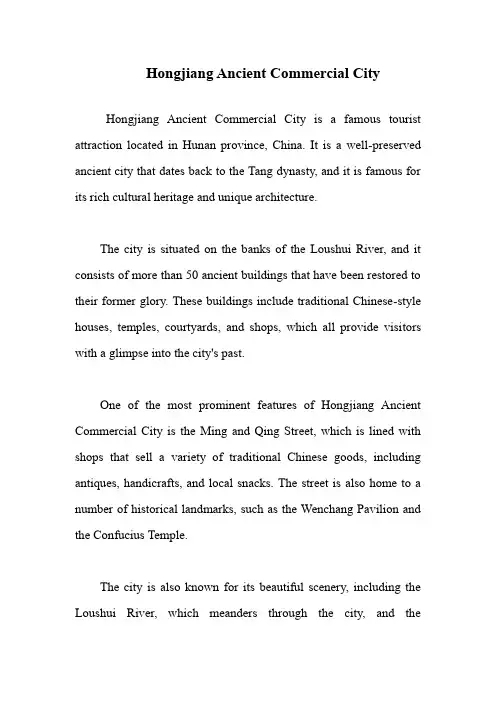
Hongjiang Ancient Commercial CityHongjiang Ancient Commercial City is a famous tourist attraction located in Hunan province, China. It is a well-preserved ancient city that dates back to the Tang dynasty, and it is famous for its rich cultural heritage and unique architecture.The city is situated on the banks of the Loushui River, and it consists of more than 50 ancient buildings that have been restored to their former glory. These buildings include traditional Chinese-style houses, temples, courtyards, and shops, which all provide visitors with a glimpse into the city's past.One of the most prominent features of Hongjiang Ancient Commercial City is the Ming and Qing Street, which is lined with shops that sell a variety of traditional Chinese goods, including antiques, handicrafts, and local snacks. The street is also home to a number of historical landmarks, such as the Wenchang Pavilion and the Confucius Temple.The city is also known for its beautiful scenery, including the Loushui River, which meanders through the city, and thesurrounding hills and ridges that are covered in lush vegetation. Visitors to Hongjiang Ancient Commercial City can enjoy a leisurely stroll through the city's streets, take a boat ride along the river, or hike in the nearby hills.Overall, Hongjiang Ancient Commercial City is a must-visit destination for anyone interested in Chinese history and culture. Its unique architecture, well-preserved ancient buildings, and beautiful scenery make it a fascinating and unforgettable destination. That's all for my introduction of Hongjiang Ancient Commercial City. If you have any questions about Hongjiang Ancient Commercial City, feel free to ask me. Thank you!。
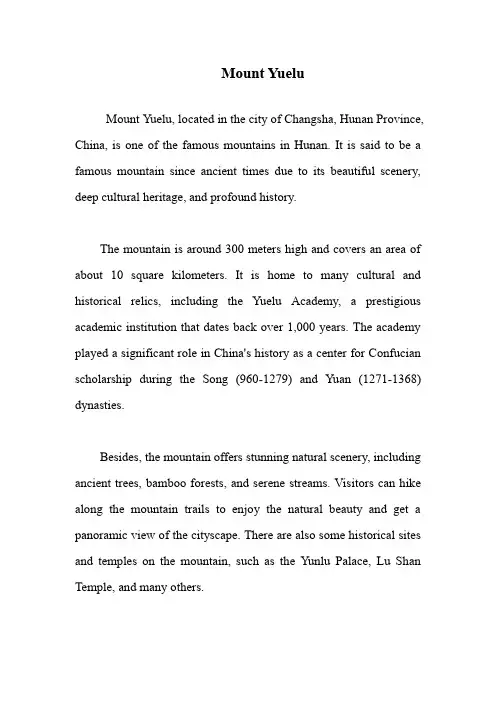
Mount YueluMount Yuelu, located in the city of Changsha, Hunan Province, China, is one of the famous mountains in Hunan. It is said to be a famous mountain since ancient times due to its beautiful scenery, deep cultural heritage, and profound history.The mountain is around 300 meters high and covers an area of about 10 square kilometers. It is home to many cultural and historical relics, including the Yuelu Academy, a prestigious academic institution that dates back over 1,000 years. The academy played a significant role in China's history as a center for Confucian scholarship during the Song (960-1279) and Yuan (1271-1368) dynasties.Besides, the mountain offers stunning natural scenery, including ancient trees, bamboo forests, and serene streams. Visitors can hike along the mountain trails to enjoy the natural beauty and get a panoramic view of the cityscape. There are also some historical sites and temples on the mountain, such as the Yunlu Palace, Lu Shan Temple, and many others.Mount Yuelu is not only a place for sightseeing but also a symbol of Changsha's culture and history. Its significance and beauty attract tourists from all over the world every year. That's all for my introduction of Mount Yuelu. If you have any questions about Mount Yuelu, feel free to ask me. Thank you!。
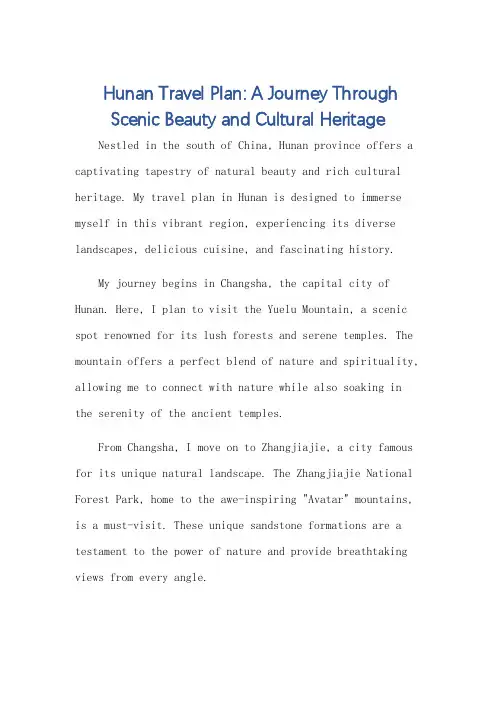
Hunan Travel Plan: A Journey ThroughScenic Beauty and Cultural HeritageNestled in the south of China, Hunan province offers a captivating tapestry of natural beauty and rich cultural heritage. My travel plan in Hunan is designed to immerse myself in this vibrant region, experiencing its diverse landscapes, delicious cuisine, and fascinating history.My journey begins in Changsha, the capital city of Hunan. Here, I plan to visit the Yuelu Mountain, a scenic spot renowned for its lush forests and serene temples. The mountain offers a perfect blend of nature and spirituality, allowing me to connect with nature while also soaking in the serenity of the ancient temples.From Changsha, I move on to Zhangjiajie, a city famous for its unique natural landscape. The Zhangjiajie National Forest Park, home to the awe-inspiring "Avatar" mountains, is a must-visit. These unique sandstone formations are a testament to the power of nature and provide breathtaking views from every angle.Another highlight of my travel plan is a visit to Fenghuang Ancient Town, a well-preserved ancient city that offers a glimpse into Hunan's rich historical and cultural past. Wandering through the cobblestone streets, I will immerse myself in the town's unique architecture,traditional crafts, and local cuisine.Of course, no trip to Hunan is complete without tasting the region's famous cuisine. I look forward to sampling the spicy and delicious Hunan-style hot pots, as well as other local delicacies like the famous Xiangcai (Hunan-style pickled vegetables) and Mao's favorite dish - red burnt pork belly.Rounding off my travel plan is a visit to the Dongjiang Lake, one of the largest freshwater lakes in China. Here, I plan to enjoy a relaxing cruise on the lake, taking in the scenic vistas and serene atmosphere. The Dongjiang Lake is also a haven for birdwatchers, with a rich diversity of avian species.In conclusion, my Hunan travel plan is designed tooffer a comprehensive experience of the province's natural beauty, cultural heritage, and delicious cuisine. From theserene temples of Yuelu Mountain to the breathtaking sandstone formations of Zhangjiajie, and from thehistorical allure of Fenghuang Ancient Town to thedelicious local dishes, Hunan promises a memorable journey through time and space.**湖南旅游计划:穿越自然美景与文化遗产的旅程** 位于中国南部的湖南省展现了一幅迷人的自然美景与丰富文化遗产的画卷。
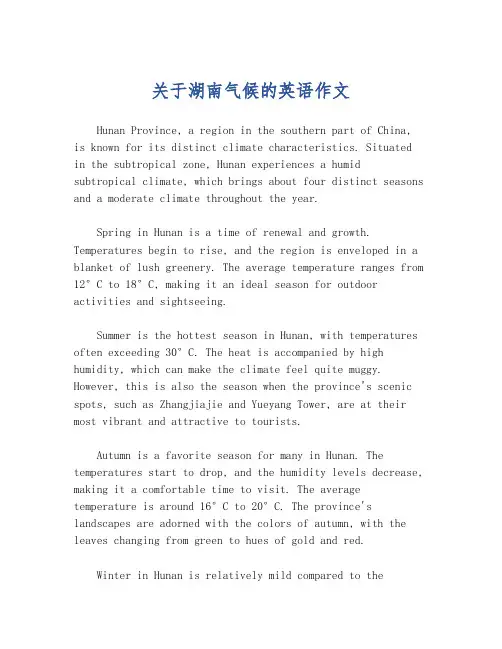
关于湖南气候的英语作文Hunan Province, a region in the southern part of China, is known for its distinct climate characteristics. Situated in the subtropical zone, Hunan experiences a humidsubtropical climate, which brings about four distinct seasons and a moderate climate throughout the year.Spring in Hunan is a time of renewal and growth. Temperatures begin to rise, and the region is enveloped in a blanket of lush greenery. The average temperature ranges from 12°C to 18°C, making it an ideal season for outdoor activities and sightseeing.Summer is the hottest season in Hunan, with temperatures often exceeding 30°C. The heat is accompanied by high humidity, which can make the climate feel quite muggy. However, this is also the season when the province's scenic spots, such as Zhangjiajie and Yueyang Tower, are at their most vibrant and attractive to tourists.Autumn is a favorite season for many in Hunan. The temperatures start to drop, and the humidity levels decrease, making it a comfortable time to visit. The average temperature is around 16°C to 20°C. The province's landscapes are adorned with the colors of autumn, with the leaves changing from green to hues of gold and red.Winter in Hunan is relatively mild compared to thenorthern parts of China. The average temperature hoversaround 4°C to 8°C. Snowfall is not uncommon, and when it does snow, the province transforms into a winter wonderland, offering a serene and picturesque setting.Overall, Hunan's climate is a blend of warmth and comfort, with each season offering its own unique charm andattractions. Whether it's the blossoming of spring, the heatof summer, the crispness of autumn, or the chill of winter, Hunan's climate is a testament to the province's natural beauty and diversity.。
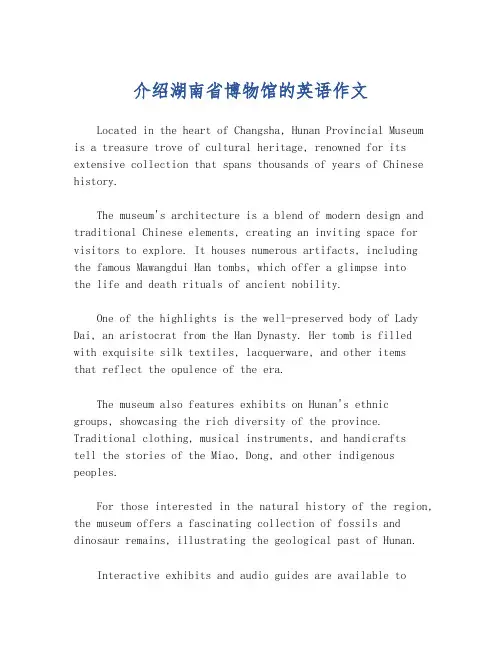
介绍湖南省博物馆的英语作文Located in the heart of Changsha, Hunan Provincial Museum is a treasure trove of cultural heritage, renowned for its extensive collection that spans thousands of years of Chinese history.The museum's architecture is a blend of modern design and traditional Chinese elements, creating an inviting space for visitors to explore. It houses numerous artifacts, including the famous Mawangdui Han tombs, which offer a glimpse intothe life and death rituals of ancient nobility.One of the highlights is the well-preserved body of Lady Dai, an aristocrat from the Han Dynasty. Her tomb is filled with exquisite silk textiles, lacquerware, and other itemsthat reflect the opulence of the era.The museum also features exhibits on Hunan's ethnic groups, showcasing the rich diversity of the province. Traditional clothing, musical instruments, and handicraftstell the stories of the Miao, Dong, and other indigenous peoples.For those interested in the natural history of the region, the museum offers a fascinating collection of fossils and dinosaur remains, illustrating the geological past of Hunan.Interactive exhibits and audio guides are available toenhance the visitor experience, making the journey through time both educational and engaging.A visit to the Hunan Provincial Museum is not just a walk through ancient China but also a step into the vibrantculture of Hunan province, providing a unique perspective on China's rich and varied history.。
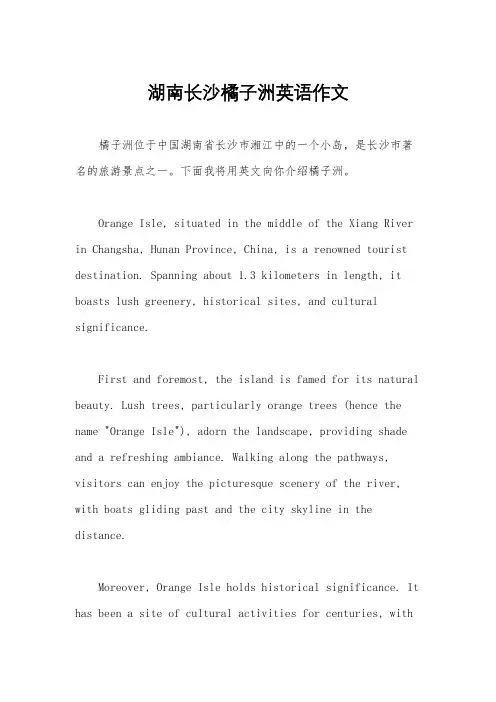
湖南长沙橘子洲英语作文橘子洲位于中国湖南省长沙市湘江中的一个小岛,是长沙市著名的旅游景点之一。
下面我将用英文向你介绍橘子洲。
Orange Isle, situated in the middle of the Xiang River in Changsha, Hunan Province, China, is a renowned tourist destination. Spanning about 1.3 kilometers in length, it boasts lush greenery, historical sites, and cultural significance.First and foremost, the island is famed for its natural beauty. Lush trees, particularly orange trees (hence the name "Orange Isle"), adorn the landscape, providing shade and a refreshing ambiance. Walking along the pathways, visitors can enjoy the picturesque scenery of the river, with boats gliding past and the city skyline in the distance.Moreover, Orange Isle holds historical significance. It has been a site of cultural activities for centuries, withvarious pavilions, temples, and monuments scattered across the island. One of the most notable landmarks is the Aiwan Pavilion, a traditional Chinese structure perched on a hill, offering panoramic views of the surroundings. The pavilion has witnessed countless poems composed and literary gatherings held throughout history.Furthermore, Orange Isle is deeply intertwined with the cultural heritage of Changsha and Hunan Province. It isoften featured in local folklore, songs, and literature, symbolizing the spirit and resilience of the people. Many cultural events and festivals are held on the island, attracting both locals and tourists alike.In addition to its natural beauty and historical significance, Orange Isle offers various recreational activities for visitors. From leisurely strolls and picnics to boat rides along the river, there's something for everyone to enjoy. The island also hosts outdoor concerts, art exhibitions, and traditional performances, adding vibrancy to its atmosphere.Overall, Orange Isle is not just a scenic spot but a symbol of the rich culture and history of Changsha and Hunan Province. Whether you're a nature lover, history enthusiast, or simply seeking relaxation, a visit to Orange Isle promises an unforgettable experience.。
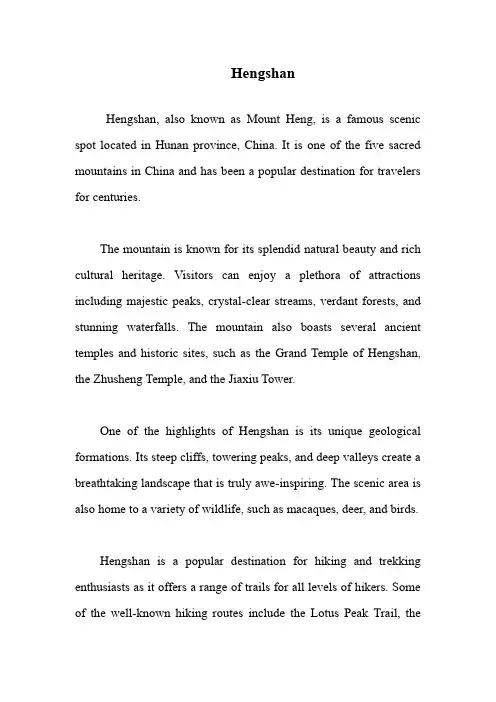
HengshanHengshan, also known as Mount Heng, is a famous scenic spot located in Hunan province, China. It is one of the five sacred mountains in China and has been a popular destination for travelers for centuries.The mountain is known for its splendid natural beauty and rich cultural heritage. Visitors can enjoy a plethora of attractions including majestic peaks, crystal-clear streams, verdant forests, and stunning waterfalls. The mountain also boasts several ancient temples and historic sites, such as the Grand Temple of Hengshan, the Zhusheng Temple, and the Jiaxiu Tower.One of the highlights of Hengshan is its unique geological formations. Its steep cliffs, towering peaks, and deep valleys create a breathtaking landscape that is truly awe-inspiring. The scenic area is also home to a variety of wildlife, such as macaques, deer, and birds.Hengshan is a popular destination for hiking and trekking enthusiasts as it offers a range of trails for all levels of hikers. Some of the well-known hiking routes include the Lotus Peak Trail, theNanyue Grand Canyon Trail, and the Zhongnan Stream Trail.Overall, Hengshan is a must-see destination for anyone visiting Hunan province. It offers a perfect blend of natural beauty and cultural heritage, making it an unforgettable experience for tourists from around the world. That's all for my introduction of Hengshan. If you have any questions about Hengshan, feel free to ask me. Thank you!。
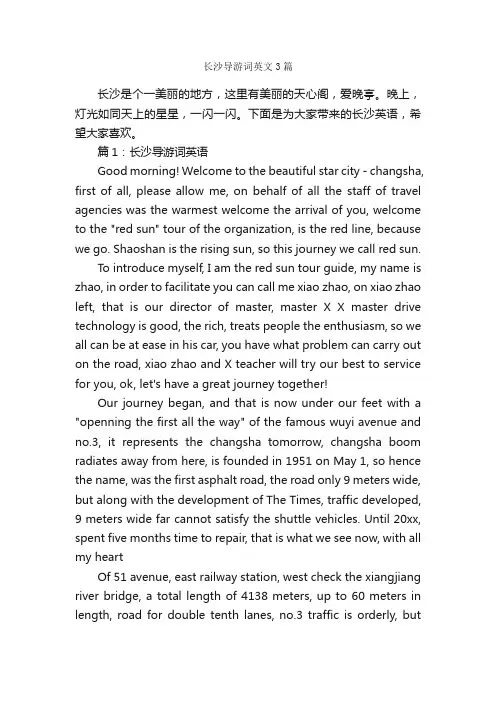
长沙导游词英文3篇长沙是个一美丽的地方,这里有美丽的天心阁,爱晚亭。
晚上,灯光如同天上的星星,一闪一闪。
下面是为大家带来的长沙英语,希望大家喜欢。
篇1:长沙导游词英语Good morning! Welcome to the beautiful star city - changsha, first of all, please allow me, on behalf of all the staff of travel agencies was the warmest welcome the arrival of you, welcome to the "red sun" tour of the organization, is the red line, because we go. Shaoshan is the rising sun, so this journey we call red sun.To introduce myself, I am the red sun tour guide, my name is zhao, in order to facilitate you can call me xiao zhao, on xiao zhao left, that is our director of master, master X X master drive technology is good, the rich, treats people the enthusiasm, so we all can be at ease in his car, you have what problem can carry out on the road, xiao zhao and X teacher will try our best to service for you, ok, let's have a great journey together!Our journey began, and that is now under our feet with a "openning the first all the way" of the famous wuyi avenue and no.3, it represents the changsha tomorrow, changsha boom radiates away from here, is founded in 1951 on May 1, so hence the name, was the first asphalt road, the road only 9 meters wide, but along with the development of The Times, traffic developed, 9 meters wide far cannot satisfy the shuttle vehicles. Until 20xx, spent five months time to repair, that is what we see now, with all my heartOf 51 avenue, east railway station, west check the xiangjiang river bridge, a total length of 4138 meters, up to 60 meters in length, road for double tenth lanes, no.3 traffic is orderly, butmost of the drivers don't want to go this way, is this why? On the road there are 3 sets of original and 6 digital television monitoring equipment, carelessly is easy to copy brand, so drivers is have a love-hate relationship!Where the source of the wuyi avenue? She is behind the changsha railway station, she construction in 1975, completed in 1977, with the Shanghai railway station ` Beijing railway station called China's three largest train station, that in the middle of the railway station there is a clock tower, tower 63.7 meters high, the clock tower at the top of the hour will be played best young's "east is red" LeDian, as if to tell you that you have come to the generation of a great man of chairman MAO's hometown - hunan. In the clock tower above, there is a building that xiao zhao excuse me everybody, think what is she like? Yes, she is the red torch. Maybe someone will ask, now that is the torch, why not be waving? But go straight into the blue sky? Xiao zhao to the problem have to explain for everybody, because before railway station built, comes at a time - leather, stylist designed to float to the left her, said there will be left; In the designed to the right, say again afraid will have the right, then, designer simply put her into a straight at the torch of the above. In fact, she is very like a specialty: let's hunan capsicum frutescens var, she is our chairman MAO's favorite kind of food, she also is a symbol of our people of hunan hot and enthusiasm, not to have such a saying: people are not afraid of spicy sichuan, guizhou people is afraid of hot, hunan people are afraid of not hot.Ok, now let's Yuan Guling overpass, why called Yuan Guling overpass? And not called Li Guling ` the wangjialing overpass? Because it is said that in the large pieces of the earth that is inhabited by a certain family. So in the construction of the bridgewas named after had to. It is built down, in addition to the beautiful and also have the effect of ease the earthquake. Can anyone who has both advantages and disadvantages, hunan is a rainy provinces, if encounter rainy weather, the bridge will be accumulated rainwater, formation water bring pedestrians through the troubles and inconvenience caused. I'm afraid this is hou only white water rafting and line!That is on the right-hand side of the xiao zhao shaoshanlu, because was not to shaoshan road, then built the road; Shaoshan.Good, that you pay attention to have a look at the trees on both sides of the tour bus, it is in the city of changsha were: camphor trees, camphor leaves small but, under the big camphor tree is a good place to enjoy cool air, using camphor tree of camphor ball can drive midge catch ants, took a few pieces of camphor tree chew Ye Qing washed into the mouth, can also be sober refreshing. About the camphor tree,In changsha, there is such a local custom, it is the parents to marry the daughter of a set of camphorwood furniture is very decent. On the left hand side, xiao zhao is welcome road, 1972, President Nixon's visit to welcome the President of the United States and to build a road. Across the welcome road is a red and white building, she is 2 hospital of hunan province the government.Were made, xiao zhao mentioned that we're here to learn about the tree of hunan province, it is the magnolia tree, it is from guangzhou introduced a tree. Suiting the city of changsha, azaleas, see the cuckoo that can want to went to the countryside, three in April, when the brilliant red cuckoo open full of hills, not to mention how beautiful. Fancy suiting of hunan province, is a hibiscus, since ancient times, hunan is known as lotus countries.Chairman MAO's poem says, "the kingdom of the lotus from zhaohui". Lotus, also can be divided into water and cotton rose hibiscus. Then xiao zhao, please everyone: "what is water lotus? Cotton rose?" Ha ha! Cotton rose is magnolia, water lotus is lotus.Ok, now let's to lotus road, beside the lotus road, changsha is the new lotus square, you can see in the middle of a sculpture, that is the daughter of liuyang river, you must be attracted by her long hair? The daughter of liuyang river nine curved hair, a symbol of the liuyang river nine bending. It reminds us of the beautiful sounds of "liuyang river", the product comforms to the drawing that xiao zhao here, give you sing a song "liuyang river", we hope you enjoy it.Okay, now we see the underlying white doves building is the famous peace hall business building. Peace in Japanese is the meaning of peace, meaning and harmonic development. There is a sino-japanese joint venture of shopping malls, Japan accounted for 60% of the company, shareholders shareholder China accounted for 40%. Before peace hall was built, the unearthed here most of the country's bamboo slips, which records the chu the history of The Three Kingdoms period, now the peace of the sixth floor display, also has people in shopping may wish to visit.In front of the hall of peace is the wuyi square, square in the middle there is a huge music fountain, at eight o 'clock every night, music fountain will dance with music. Now please look the top of the wuyi square, you can see a small house, like the eyes there is big eyes "- the voice of the golden eagle.篇2:长沙导游词英语Changsha, though not nearly as prosperous Hong Kong than atmosphere in Beijing, but still has her own beauty.Changsha is a beautiful place, there are beautiful as pavilion,love late pavilion. At night, lights, like the stars in the sky, twinkle.Changsha charactizing a fine spring, spring breeze blow gently. Sunshine in March, the flower is gorgeous. The flower azalea is indescribable.Summer, known as the "four big stove" one of changsha is hot. Cicada hot straight called "cicadas, cicada," dog hot tongue, floppy chicken wings. No matter how the weather during the day, children come out to play, so they had a hot, can't help but to the sun.Autumn, the leaves fall, the fruit is ripe, the farmer uncle smile red in the face. The wild goose south, ants and squirrels have in preparation for winter food.Winter, heavy snow, the children can be happy, because you can snowball fights, make a snowman! Leaves a also have no, many small animals also for the winter. The children are in the warm home looking at the beautiful snow...Changsha year the four seasons scenery attractive, no matter day or night, she is always a kind face.Changsha snack is to let a person dazzling, stinky tofu, bean jelly, roast sweet potato, onion cakes, taste shrimp, sucking screw... Is numerous, even the saliva all can't help flow down.Changsha tourist resort also has a lot of, such as: taiping street, small Simon, as pavilion, baisha ancient, yuelu academy, and so on some places of interest. But they speak well "nobody's perfect, gold without gather" changsha ointment is loop mirror is not good, can see garbage everywhere, air is polluted by a lot.Changsha is our common home, when I grow up must see her construction better, become a more attractive city.篇3:长沙导游词英语Changsha city, referred to as "long, nickname" star city ", "chucity", is also the provincial capital of hunan province, my hometown. By mountain city is the most valuable gift of nature to changsha. The beautiful land of write too much better on historical spanning, dufu.longhai left "jiangnan landscape, the fallen petal season and every gentleman" song of eternal; Zhang Shi song dynasty, zhu xi in yuelu academy teaching twice; More generation great man MAO zedong crowd j head, high-spirited, encouraging words...When it comes to changsha, people naturally think of j head, the xiangjiang river sight. Orange continent, some people say that it is a painting, plum for spring, zhu qing Elizabeth Barbara ohm, orange, yellow, orange, green, silver. Orange continent, someone says it is a poem, between heaven and earth day flow, the ancient and modern in character. The emotion recalling ancientry, master the ups and downs. Orange continent, is the green pearl inlaid in the xiangjiang river, changsha is the pride of the people. Xiangjiang river sight all sight fully reflects the natural scenery in hunan province, a beautiful environment, is a good place for tourists sightseeing trip, and citizen exercise night tour of the state. Xiangjiang river is the mother river of the changsha, it surging south, bubbling to the north, zhao mountain in changsha city, the three han alum turned to the northwest, to Joe for wangcheng, in yueyang dongting, through the changsha city about 25 kilometers. The xiangjiang river on both sides of the red cliff, such as chardonnay, white as snow, sand willows, such as silk, Qiang sails as a cloud, make a beautiful sight along the river in changsha.When it comes to changsha, nature is little not food. Hunan cuisine is one of the eight great cuisines of China. Today changsha delicacies already known: squid spicy small lobster, ironplate, stinky tofu, hot and sour powder... Eating in changsha, oneself of breath, "food" is interesting, such as "eat" such as drunk. In star city streets, how many traditional snacks waiting for, and how many trendy snack make people hope.With the expansion of the city, the changes of flickering skyscrapers. At the same time, the street is lined with trees on both sides, we like to live in the garden. Straight, clean, clean, spacious avenue of traffic of the city changes with each passing day, make the camp of the new road tunnel urbanization construction on a new stage; Wuhan-guangzhou high-speed accelerated economic exchanges and coastal cities in central China, greatly improved the living standards of people; The city subway and light rail would be built and also greatly facilitates people's travel.Changsha, zhuzhou and xiangtan urban agglomeration in 20xx formally approved by the national construction of a resource-conserving and environment-friendly comprehensive reform pilot area, become the rise of central China "engine", drive the economic development of China. Was to press evaluation, "changzhutan economic integration both experience and lessons, whether success or setbacks, will be to the Yangtze river delta, the pearl river delta, bohai sea region these newcomers profound enlightenment." Believe in changsha will be more beautiful tomorrow.I love my hometown, my beautiful star city - changsha.。
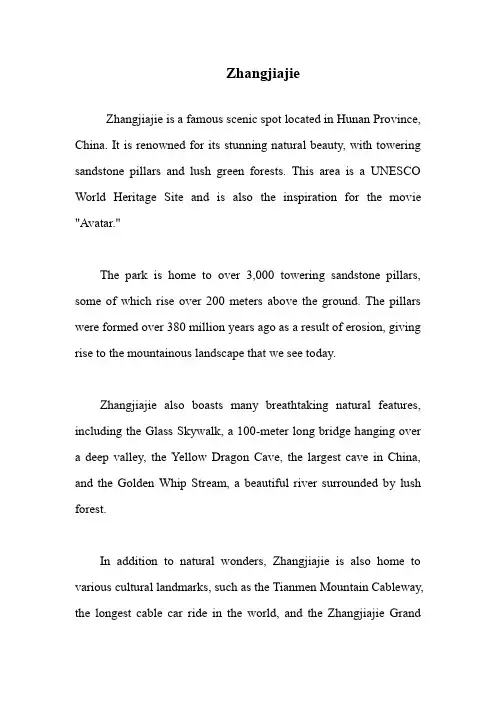
ZhangjiajieZhangjiajie is a famous scenic spot located in Hunan Province, China. It is renowned for its stunning natural beauty, with towering sandstone pillars and lush green forests. This area is a UNESCO World Heritage Site and is also the inspiration for the movie "Avatar."The park is home to over 3,000 towering sandstone pillars, some of which rise over 200 meters above the ground. The pillars were formed over 380 million years ago as a result of erosion, giving rise to the mountainous landscape that we see today.Zhangjiajie also boasts many breathtaking natural features, including the Glass Skywalk, a 100-meter long bridge hanging over a deep valley, the Yellow Dragon Cave, the largest cave in China, and the Golden Whip Stream, a beautiful river surrounded by lush forest.In addition to natural wonders, Zhangjiajie is also home to various cultural landmarks, such as the Tianmen Mountain Cableway, the longest cable car ride in the world, and the Zhangjiajie GrandCanyon Glass Bridge, the longest and highest glass bridge in the world.Overall, Zhangjiajie is a must-see destination for anyone visiting China, offering a pristine natural experience that is unlike any other. That's all for my introduction of Zhangjiajie. If you have any questions about Zhangjiajie, feel free to ask me. Thank you!。
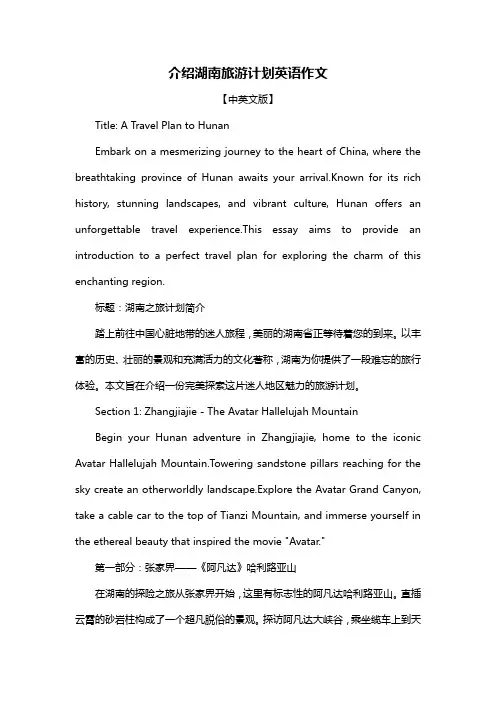
介绍湖南旅游计划英语作文【中英文版】Title: A Travel Plan to HunanEmbark on a mesmerizing journey to the heart of China, where the breathtaking province of Hunan awaits your arrival.Known for its rich history, stunning landscapes, and vibrant culture, Hunan offers an unforgettable travel experience.This essay aims to provide an introduction to a perfect travel plan for exploring the charm of this enchanting region.标题:湖南之旅计划简介踏上前往中国心脏地带的迷人旅程,美丽的湖南省正等待着您的到来。
以丰富的历史、壮丽的景观和充满活力的文化著称,湖南为你提供了一段难忘的旅行体验。
本文旨在介绍一份完美探索这片迷人地区魅力的旅游计划。
Section 1: Zhangjiajie - The Avatar Hallelujah MountainBegin your Hunan adventure in Zhangjiajie, home to the iconic Avatar Hallelujah Mountain.Towering sandstone pillars reaching for the sky create an otherworldly landscape.Explore the Avatar Grand Canyon, take a cable car to the top of Tianzi Mountain, and immerse yourself in the ethereal beauty that inspired the movie "Avatar."第一部分:张家界——《阿凡达》哈利路亚山在湖南的探险之旅从张家界开始,这里有标志性的阿凡达哈利路亚山。
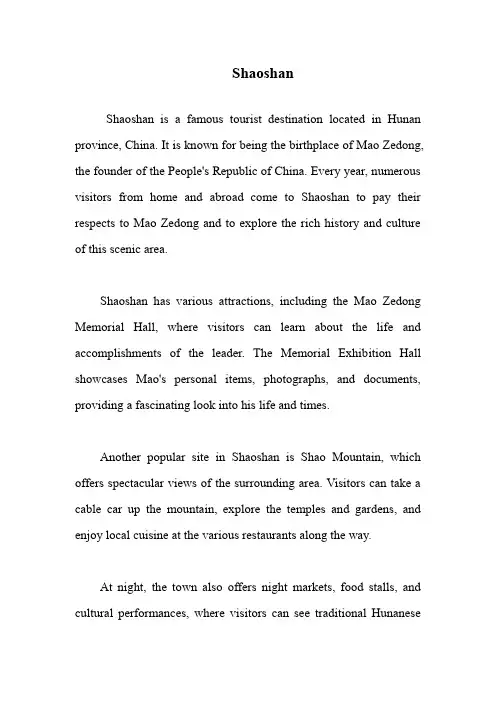
ShaoshanShaoshan is a famous tourist destination located in Hunan province, China. It is known for being the birthplace of Mao Zedong, the founder of the People's Republic of China. Every year, numerous visitors from home and abroad come to Shaoshan to pay their respects to Mao Zedong and to explore the rich history and culture of this scenic area.Shaoshan has various attractions, including the Mao Zedong Memorial Hall, where visitors can learn about the life and accomplishments of the leader. The Memorial Exhibition Hall showcases Mao's personal items, photographs, and documents, providing a fascinating look into his life and times.Another popular site in Shaoshan is Shao Mountain, which offers spectacular views of the surrounding area. Visitors can take a cable car up the mountain, explore the temples and gardens, and enjoy local cuisine at the various restaurants along the way.At night, the town also offers night markets, food stalls, and cultural performances, where visitors can see traditional Hunanesedance and music performances.Overall, Shaoshan is a must-visit destination for those interested in Chinese history and culture. With its stunning scenery, rich history, and engaging attractions, it is a popular destination for both domestic and international travelers. That's all for my introduction of Shaoshan. If you have any questions about Shaoshan, feel free to ask me. Thank you!。
Peach Blossom LandTaohuayuan, or Peach Blossom Land, is a famous scenic spot in Hunan, China. Located in the Xiangxi River Valley in the Xiangxi Tujia and Miao Autonomous Prefecture, it is a picturesque place that has attracted visitors for centuries.The name Taohuayuan comes from a legendary story which tells of a fisherman stumbling upon a utopian village where the people live a simple and harmonious life. The village is surrounded by peach blossoms, and it is said that those who visit will experience eternal happiness and peace.The actual Peach Blossom Land is a beautiful valley surrounded by rolling hills covered in greenery. Visitors can take a leisurely stroll along the stream that runs through the valley, admire the colorful flowers, and take in the fresh mountain air. The best time to visit Taohuayuan is in the spring, when the peach blossoms are in full bloom. At this time, the valley is transformed into a sea of pink and white, creating a stunning and vibrant backdrop for visitors to enjoy.In addition to the natural beauty, there are also historic and cultural relics in the area. The Taoist Temple of Peace and Harmony, built during the Tang Dynasty, is a popular attraction in Taohuayuan, as is the statue of Xu Xiake, a famous Ming Dynasty geographer and travel writer who wrote about his visit to the area in his travel journals.Overall, Taohuayuan is a magical place that combines breathtaking natural scenery, fascinating cultural history, and a serene atmosphere. It is an absolute must-visit for anyone traveling to Hunan, and a place that many visitors come back to time and time again. That's all for my introduction of Taohuayuan. If you have any questions about Peach Blossom Land, feel free to ask me. Thank you!。
湖南的英语介绍Hunan is a province of China, located in the middle reaches of the Yangtze River and south of Lake Dongting (hence the name Hunan, meaning "south of the lake"). Hunan is sometimes called Xiang for short, after the Xiang River which runs through the province.Hunan borders Hubei in the north, Jiangxi to the east, Guangdong to the south, Guangxi to the southwest, Guizhou to the west, and Chongqing to the northwest. The capital is Changsha.HistoryHunan entered the written history of China around 350 BC, when under the kings of the Zhou dynasty it became part of the State of Chu. Until then Hunan was a land of primeval forests, occupied by the ancestors of the modern Miao, Tujia, Dong and Yao peoples, but starting at this time and for hundreds of years thereafter it was a magnet for migration of Han Chinese from the north, who cleared most of the forests and began farming rice in the valleys and plains. To this day, many of the small villages in Hunan are named after the Han families which originally settled there. Migration from the north was especially prevalent during the Eastern Jin Dynasty and the Southern and Northern Dynasties Periods, when nomadic invaders overran the north.During the Five Dynasties and Ten Kingdoms Period, Hunan was home to its own independent regime, Ma Chu.Hunan, was, together with Hubei, a part of the province of Huguang till the Qing dynasty.Hunan became an important communications center from its position on the Yangzi River (Changjiang) and on the Imperial Highway constructed between northern and southern China. Its land produced grain so abundantly that it fed many parts of China with its surpluses. The population continued to climb until, by the nineteenth century, Hunan was overcrowded and prone to peasant uprisings.The Taiping Rebellion which began to the south in Guangxi Province in 1850 spread into Hunan and then further eastward along the Yangzi River valley, but ultimately it was a Hunanese army under Zeng Guofan which marched to Nanjing and put down the uprising in 1864.Hunan was relatively quiet until 1910 when there were uprisings against the crumbling Qing dynasty, which were followed by the Communist's Autumn Harvest Uprising of 1927 led by Hunanese native Mao Zedong, which established a short-lived Hunan soviet in 1927. The Communists maintained a guerilla army in the mountains along the Hunan-Jiangxi border until 1934, when under pressure from the Nationalist (Kuomintang, KMT) forces they began the famous Long March to bases in Shaanxi Province. After the departure of the Communists, the KMT army fought against the Japanese in the second Sino-Japanese war, defending the capital Changsha until it fell in 1944, when Japan launched Operation Ichigo to control the railroad from Wuchang to Guangzhou (Yuehan Railway). Hunan was relatively unscathed by the civil war that followed the defeat of the Japanese in 1945, and in 1949 the Communists returned once more as the Nationalists retreated southward.Being Mao Zedong's home province, Hunan supported the Cultural Revolution of 1966-1976, and was slower than most provinces in adopting the reforms implemented by Deng Xiaoping in the years that followed Mao's death in 1976.Former Chinese Premier Zhu Rongji is also Hunanese.GeographyHunan Province is located on the south bank of the Yangtze River (Changjiang, 长江), about half way along its length. Shanghai lies 1000 km away, Beijing 1200 km away, and Guangzhou 500 km away.Hunan is situated between 109°-114° east longitude and 20°-30° north latitude. The east, south and west sides of the province are surrounded by mountains and hills, such as the Wuling Mountains to the northwest, the Xuefeng Mountains to the west, the Nanling Mountains to the south, and the Luoxiao Mountains to the east. The mountains and hills occupy more than 80% of the area and the plain comprises less than 20% of the whole province.The Xiangjiang, the Zijiang, the Yuanjiang and the Lishui Rivers converge on the Yangtze River at Lake Dongting (Dongting Hu, 洞庭湖) in the north of Hunan. The center and northern parts are somewhat low and a U-shaped basin, open in the north and with Lake Dongting as its center. Most of Hunan Province lies in the basins of four major tributaries of the Yangtze River.Lake Dongting is the largest lake in the province and the second largest freshwater lake of China. Due to the reclamation of land for agriculture, Lake Dongting has been subdivided into many smaller lakes, though there is now atrend to reverse some of the reclamation, which had damaged wetland habitats surrounding the lake.Hunan's climate is subtropical, with mild winters and plenty of precipitation. January temperatures average 3 to 8°C while July temperatures average around 27 to 30°C. Average annual precipitation is 1200 to 1700 mm.EconomyHunan's traditional crop is rice. The Lake Dongting area is an important center of ramie production, and Hunan is also an important center of tea cultivation.The Lengshuijiang area is noted for its stibnite mines, and is one of the major centers of antimony extraction in China.Its nominal GDP for 2004 was 561.2 billion yuan (US$69.62 billion). In 2004, its per capita GDP was 8,423 yuan (US$1,040).。